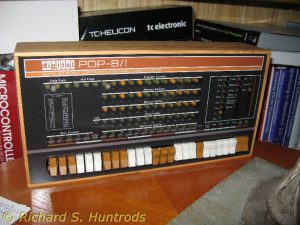As stated previously in my blog, I’ve been having tons of fun playing with my PDP8/I replica, the PiDP8 designed by Oscar Vermeulen and sold as a kit. The engine for the replica is a Raspberry Pi (3, in my case) running Simh, an awesome ‘old iron’ simulator that runs on many platforms.
I was intrigued by the idea of MULTOS/8 after reading an inquiry about it on Oscar’s PiDP8 forum. I did a bit of digging, and found that a few folks were interested, but none (apparently) had it running on Simh.
I was able to obtain a copy from the PDP repository at https://www.pdp8online.com/images/images/os8.shtml and began.
The disk image is multos8.rk05, indicating it’s a disk pack much like the standard OS8 operating system. After some playing, I have been able to get MULTOS/8 running successfully on my PiDP8.
The general procedure is to boot OS8, then enter SIMH and attach the multos disk image to RK1, while detaching the OS8 image. In place of the OS8 disk image on RK0, you attach a new file as disk image (mine was called rsh.rk05). Then you boot to MULTOS8 in a maintenance mode. In that mode, you format (ZERO) the blank disk image and copy the MULTOS files to the blank disk. Now you can boot MULTOS into timeshare mode and play.
One quick note on paths for SIMH on the PiDP8: I put my image files in /opt/pidp8/imagefiles/rsh to keep them separate from Oscar’s default files. SIMH finds files relative to /opt/pidp8, hence the ‘../imagefiles/rsh/rsh.rk05’ path. You are free to put your files where you want as long as SIMH can see them.
Here are the detailed steps:
Begin with the normal OS8 boot.
<ctrl-e> (to get into simh)
*Command Notes & comments
det rk0 Detach the OS8 boot disk from rk0
att rk1 ../imagefiles/rsh/multos8.rk05 Attach the MULTOS8 boot disk to rk1
att rk0 ../imagefiles/rsh/rsh.rk05 Attach rk0 to a new file ‘rsh.rk05’. This will be the timeshare boot drive.
boot rk1 Boot MULTOS/8 in maintenance mode
*Now booted to MULTOS/8 maintanance mode Looks and acts just like OS8 standard boot)
DIR RKA1: Directory listing of MULTOS/8 disk, first partition
DIR RKB1: Directory listing of MULTOS/8 disk, second partition
DIR RKA0: Will show nothing (or error) as the disk has not been ‘created’ yet.
ZERO RKA0:/Y This initializes the RKA0: disk (rsh.rk05). You will be asked to confirm. **
COPY RKA0:<RKB0:*.* Copy all the files on the MULTOS/8 primary disk to the new disk.
DIR RKA0: Directory listing of RKA0:, now the same as RKA1:
DATE 23-JUN-70 Only dates in the ’70s work. This is needed to boot MULTOS8.
R MULTOS It will ask for a time in hhmm format, then boot to timeshare mode.
<ctrl-h> Log in user 1. There is no password so just press enter to get the ‘.’ prompt.
DIR This will show RKA0: listing, which is now the boot/default drive for timeshare.
R SYSTAT A command to show system status.
R LOGOFF A command to log off the user.
With this I was able to play on terminal 1 (the console) as user 1. I don’t have serial terminals set up for my PiDP8, so can’t check other terminals. That’s a future project.
Critical NOTE: The /Y option on the zero command is critical as it makes the new disk bootable. If you omit the /y flag, then MULTOS will simply stall after you try and log in.
Here’s a sample session:
.R MULTOS
HELLO !
THIS IS THE MULTOS/8 MULTI-USER OS/8 TIMESHARING SYSTEM
CREATED BY COMPUTER METHODS
7822 OAKLEDGE ROAD
SALT LAKE CITY, UTAH 84121, USA
PHONE 801-942-8000
PLEASE INPUT TIME IN 24-HOUR FORMAT
(E.G. 0925 FOR 9:25 AM AND 1935 FOR 7:35 PM):
1022
THANK YOU !
THE SYSTEM IS NOW TIMESHARING
TYPE CONTROL/H TO LOG ON.
PLEASE LOGON
.R SYSTAT
MULTOS-8 SYSTEM STATUS 1-JUN-1978 AT 12:27:10
UNASSIGNED MEMORY 16 K SWAPPING FIELDS 6 MAX NO. USERS 2
JOB ACTIVE BUSY
SELF 1 0 TTY I/O WAIT AT PC 6651
LPT 1 1
MEMORY USEAGE
FIELD JOB REL FIELD
LPT QUEUE EMPTY
.
